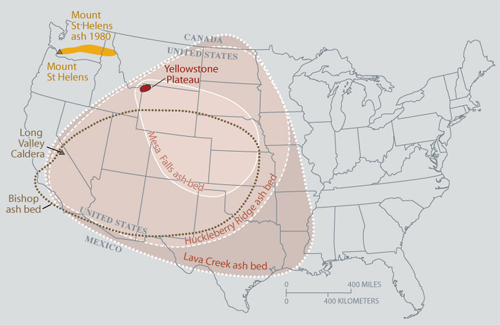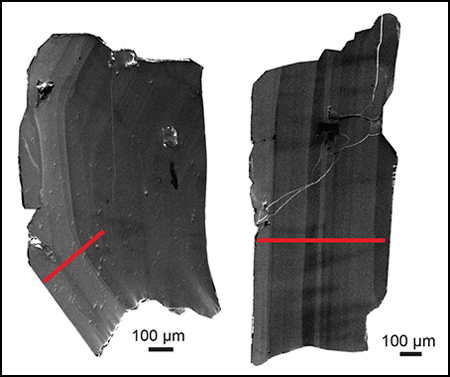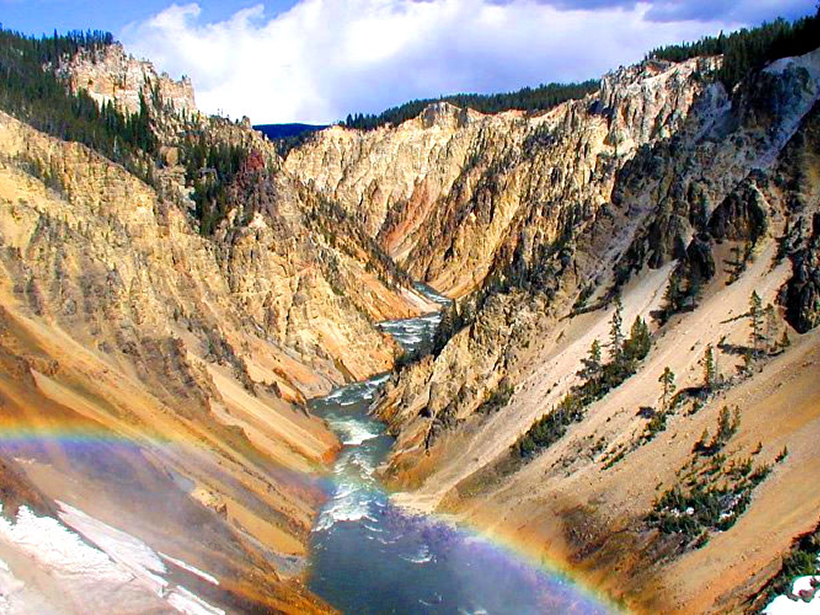Yellowstone National Park is renowned for more than just its hot springs and Old Faithful. The area is famous in the volcanology community for being the site of three explosive supereruptions, the last of which was 631,000 years ago.

During that eruption, approximately 1000 cubic kilometers of rock, dust, and volcanic ash blasted into the sky. Debris rained across the continental United States, spanning a rough triangle that stretches from today’s Canadian border down to California and over to Louisiana. In places, ash reached more than a meter thick.
“If something like this happened today, it would be catastrophic,” said Hannah Shamloo, a geologist at Arizona State University’s School of Earth and Space Exploration in Tempe. “We want to understand what triggers these eruptions, so we can set up warning systems. That’s the big-picture goal.”
Now, Shamloo and her coauthor think they’ve found a clue. By examining trace elements in crystals that they found in the volcanic leftovers of Yellowstone’s last supereruption, they might be able to pinpoint what triggered it.
Outer Rims
Just outside Yellowstone National Park is a thick multicolored, multilayered rock formation called the Lava Creek Tuff. Tuffs are igneous rocks formed by the volcanic debris left behind by an explosive eruption.
Minerals in these tuffs can tell scientists about conditions inside the volcano before it erupted, and identifying these preeruptive conditions may help inform current hazard assessments.

Shamloo and her Ph.D. adviser at Arizona State University, geologist Christy Till, examined two crystals of feldspar that they found embedded in the tuff. These crystals, called phenocrysts, form as magma cools slowly beneath the volcano.
These phenocrysts, measuring between 1 and 2 millimeters in diameter, were too large to have formed when hot material was flung up during the eruption.
Instead, as Shamloo explained, they grew gradually over time in Yellowstone’s magma chamber, each crystal beginning with a core that slowly and steadily enlarged outward, layer upon layer. As surrounding magma conditions—temperature, pressure, and water content— changed, trace elements surrounding the growing phenocrysts also changed and became incorporated into subsequent layers.
In this way, the differences in chemical composition between the phenocryst core and successive layers serve as a map of changing conditions deep within the volcano over time. What’s more, the phenocrysts’ outermost rims represent the magma that surrounded the crystal right before Yellowstone erupted.
Thus, by analyzing the outer rims, Shamloo and Till could gather both temperature and trace element information just prior to the massive explosion.
Bubble, Bubble, Toil and Trouble

Temperature information locked in a phenocryst’s outer rims can be extracted using a technique called feldspar thermometry. The technique relies on the fact that certain minerals vary their compositions in known ways as temperatures change. Thus, scientists can work backward from the exact compositions of minerals present in these outer rims to estimate the surrounding temperature when the crystal rim formed.
The duo found signatures in the rims that point to an increase in temperature and uptick in the element barium in the magma just before the eruption. They presented their research on 13 December at the American Geophysical Union’s Fall Meeting in San Francisco, Calif.
To verify their layer by layer analysis of temperature and chemical composition, Shamloo and Till used MELTS, a software program that models how the crystal composition changed as a function of temperature, pressure, and water content in the magma chamber. They assumed that the magma had the same bulk composition as the Lava Creek Tuff. Their results and the model agreed well but pointed to a low water content for the magma chamber involved in the recent supereruption. In contrast, an older eruption from the Long Valley Caldera that produced the Bishop Tuff had 5% water by weight, 5 times more than the one that produced the Lava Creek Tuff.
“There are multiple ways to trigger an eruption, but as of now, we’re seeing evidence for a magma injection.”
The low water content is surprising, Shamloo explained, because water and steam create pressures that can trigger eruptions. But Shamloo said that the phenocrysts’ story of hotter temperatures and more barium in the magma chamber just prior to the eruption suggests a possible culprit behind the explosion: the mixing of neighboring pockets of semimelted magma, called an injection event. “There are multiple ways to trigger an eruption, but as of now, we’re seeing evidence for a magma injection,” she said.
Magma, molten or semimolten rock that exists in layers of the Earth’s crust, can also reach the Earth’s surface. Because it is less dense than surrounding rocks, magma can move upward through cracks in the Earth’s crust, but when its motion is stymied, it pools into magma chambers. These chambers expand thanks to magma injections, when hotter material from deeper volcanic reservoirs feeds into shallower ones. This injection of hotter material just before the eruption may explain the temperature increase recorded in the phenocrysts.
But the presence of barium in the phenocrysts is a smoking gun, said Shamloo. “Barium doesn’t like to be in the crystal. It likes to hang out in the melt, so this tells us the barium must’ve been introduced from a different source.” The duo thinks this source is a deeper reservoir inside the volcano.
Eric Christiansen, a volcanologist from Brigham Young University in Provo, Utah, who was not involved with the study, was skeptical of Shamloo’s use of the MELTS software and thinks this type of modeling isn’t as reliable as “real experiments with real rocks.” However, he asserted, “her work is sound, and her analysis is solid. She’s got interesting trace element data with the barium, a late addition to the chamber, which suggests it accompanies what triggered the eruption.”
Geologic Crystal Ball
“The public is always afraid of the ‘next big one.’ And I like to ask, ‘Can we really forecast that?’”
“The public is always afraid of the ‘next big one,’” Shamloo said. “And I like to ask, ‘Can we really forecast that?’” Shamloo and Till hope that they can.
Knowing the eruption trigger is just the first step, according to Shamloo. The next step is understanding what order of time—days, months, even years—these changes can take before an eruption like the one that produced the Lava Creek Tuff.
Such information could help Shamloo, Till, and others to correctly read signs of volcanic unrest at Yellowstone and to create a model for predicting future supereruptions.
—Aylin Woodward (email: [email protected]; @AylinWoodward), Freelance Science Writer
Citation:
Woodward, A. (2017), Pinpointing the trigger behind Yellowstone’s last supereruption, Eos, 98, https://doi.org/10.1029/2017EO065953. Published on 04 January 2017.
Text © 2017. The authors. CC BY-NC-ND 3.0
Except where otherwise noted, images are subject to copyright. Any reuse without express permission from the copyright owner is prohibited.

